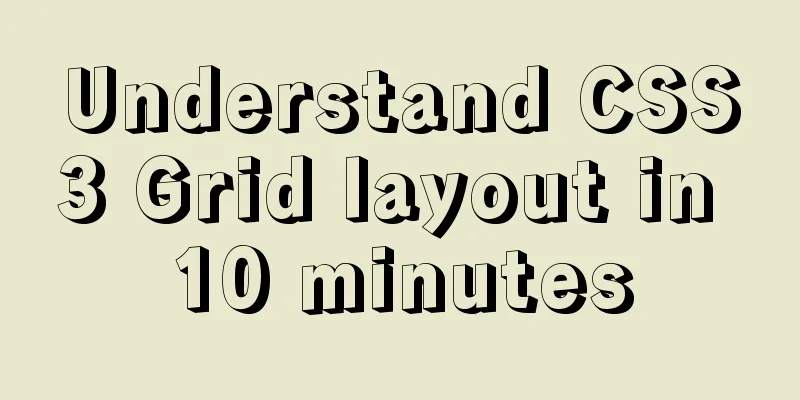Understand CSS3 Grid layout in 10 minutes

|
Basic Introduction In the previous article, we introduced CSS3 flexbox. Today, let’s talk about another powerful feature of CSS3: Grid. Grid should be very familiar to front-end developers. It is translated into Chinese as "grid". Those who have used bootstrap, semantic ui, and ant design must be familiar with grid layout. In the past, grid layout in CSS frameworks was generally implemented through float and percentage width. This implementation has several disadvantages:
Of course, grid can also be implemented with flex, but it is not much simpler than using float, and flex is good at one-dimensional space layout, but not good at two-dimensional space like grid. Now CSS3 has implemented grid from the specification and standard level, and the programming experience has been greatly improved! compatibility
usage Grid is a two-dimensional grid system consisting of several columns and rows. 1. Column (1) Set columns The Grid in CSS3 can be divided into any number of columns, and the width of each column can be set arbitrarily! Let's look at a simple example: html:
<div id="content">
<div>1</div>
<div>2</div>
<div>3</div>
<div>4</div>
<div>5</div>
<div>6</div>
<div>7</div>
<div>8</div>
<div>9</div>
</div>css:
body{
color: #fff;
text-align: center;
}
#content{
display: grid;
grid-template-columns: 33.3% 33.3% 33.3%;
max-width: 960px;
margin: 0 auto;
}
#content div{
background: lightgrey;
padding: 30px;
}
#content div:nth-child(even){
background: skyblue;
}Effect:
When we set We can also change the number and width of columns arbitrarily, for example:
#content{
grid-template-columns: 10% 20% 30% 40%;
}Effect:
(2) fr (fraction) CSS3 introduces a new unit FR (fraction), which means "fraction" in Chinese. It is used to replace percentage. Because percentages (decimals) are not divisible, using fractions can avoid writing multiple decimal places. For example, a grid with three columns of equal width can be represented as: grid-template-columns: 1fr 1fr 1fr; (3) repeat We can also use the grid-template-columns: repeat(3, 1fr); When we need to define a large number of columns, repeat becomes very useful. For example, if we want to define a grid with 10 columns of equal width, we can write 2. Row (1) Set row After we set the column, the row will be automatically generated due to the line break of the element, but we can still set the number and height of the row. CSS:
#content{
display: grid;
grid-template-columns: repeat(3, 1fr);
grid-template-rows: repeat(4, 60px);
max-width: 960px;
}Effect:
You can see that although there is no content in the fourth row, the row does exist and occupies that space. (2) minmax In the above example, we give the row a fixed height, which leads to a problem: if a grid item contains a lot of content, part of the content will not be displayed due to the fixed height, as shown below:
To solve this problem, CSS provides the CSS: grid-auto-rows: minmax(60px, auto); // or grid-template-rows: repeat(3, minmax(60px, auto)); Effect:
(3) Grid gap If we want to add spacing between rows and columns, there are also ready-made methods: css:
grid-gap:{
10px;
}Effect:
3. Grid Line In all the above examples, each grid item in the grid is arranged in the default order. What if we want to rearrange the layout and change the position or size of the grid item? For this purpose, the concept of grid lines is introduced. The so-called grid lines are the dividing lines after the grid is divided into several equal parts. The horizontal and vertical lines numbered 1 to 8 in the figure below are grid lines: <img src="http://lc-jOYHMCEn.cn-n1.lcfi...;/> By defining the starting and ending grid lines of the grid item, we can control the position and coverage area of the grid item. A simple example: html:
<div id="content">
<div class="one">1</div>
</div>css:
#content {
display: grid;
grid-template-columns: repeat(8, 100px);
grid-template-rows: repeat(8, 100px);
grid-gap: 10px;
}
.one {
grid-column-start: 3;
grid-column-end: 6;
grid-row-start: 3;
grid-row-end: 6;
}Effect:
By setting
.one {
grid-column: 3 / 6;
grid-row: 3 / 6;
}
// or .one {
grid-area: 3 / 3 / 6 / 6;
}If the grid item's starting grid line is default, we can just set its span:
.one{
grid-column: span 3;
grid-row: span 3;
}4. Grid Area Template In addition to layout through grid lines, CSS3 provides a more powerful layout method: grid area template. Rather than explaining what a grid area template is, let's look at the code: html:
<div id="content">
<header>Header</header>
<main>Main</main>
<section>Section</section>
<aside>Aside</aside>
<nav>Nav</nav>
<footer>Footer</footer>
</div>css:
body {
color: #fff;
text-align: center;
}
#content {
display: grid;
grid-template-columns: repeat(4, 1fr);
grid-auto-rows: minmax(100px, auto);
max-width: 960px;
margin: 0 auto;
grid-gap: 10px;
grid-template-areas:
"header header header header"
"aside . main main"
"nav . main main"
"section section section section"
"section section section section"
"footer footer footer footer";
}
#content>* {
background: #3bbced;
padding: 30px;
}
header { grid-area: header; }
main { grid-area: main; }
section{ grid-area: section; }
aside { grid-area: aside; }
nav { grid-area: nav; }
footer { grid-area: footer; }Effect:
Do you understand? The key point is The advantages of using grid area template are also obvious when implementing responsive layout. We only need to formulate different grid area templates for different screen sizes. 5. Justify and Align Similar to flex, grid can also set justify and align to adjust the horizontal and vertical alignment of grid items. It also supports settings for grid container or individual grid item. Set the grid container html:
<div id="content">
<div class="one">1</div>
<div>2</div>
<div>3</div>
<div>4</div>
<div>5</div>
<div>6</div>
</div>css:
#content {
display: grid;
grid-template-columns: repeat(3, 1fr);
grid-template-rows: repeat(2, minmax(120px, auto));
grid-gap: 10px;
max-width: 960px;
align-items: start;
justify-items: end;
}Effect:
Note: flex uses Set the grid item CSS:
.one{
align-self: start;
justify-self: end;
}Effect:
practice With the above knowledge, we can use CSS3 Grid to quickly create various layout effects. Here are a few simple codepen examples: 12-column grid layout Petal layout Responsive layout The above is the full content of this article. I hope it will be helpful for everyone’s study. I also hope that everyone will support 123WORDPRESS.COM. |
<<: Docker setting windows storage path operation
>>: WebWorker encapsulates JavaScript sandbox details
Recommend
Common structural tags in XHTML
structure body, head, html, title text abbr, acro...
The table table uses: nth-child() to achieve alternate color change and alignment
Core code <!DOCTYPE html> <html lang=&qu...
Steps to configure IIS10 under Win10 and support debugging ASP programs
Microsoft IIS IIS (Internet Information Server) i...
Detailed tutorial on how to modify the root password after forgetting it in MySQL 5.7
Preface For a long time, the application and lear...
Linux (center OS7) installs JDK, tomcat, mysql to build a java web project running environment
1. Install JDK 1. Uninstall the old version or th...
Summary of mysqladmin daily management commands under MySQL (must read)
The usage format of the mysqladmin tool is: mysql...
The actual process of implementing the guessing number game in WeChat applet
Table of contents Function Introduction Rendering...
Basic usage and pitfalls of JavaScript array sort() method
Preface In daily code development, there are many...
js realizes the effect of Tanabata confession barrage, jQuery realizes barrage technology
This article shares the use of js and jQuery tech...
Teach you to implement a simple promise step by step
Table of contents Step 1: Build the framework Ste...
The whole process record of introducing Vant framework into WeChat applet
Preface Sometimes I feel that the native UI of We...
Detailed explanation of how to dynamically enable/disable hyperthreading technology in Linux
Preface Intel's hyper-threading technology al...
Vue implements a simple marquee effect
This article shares the specific code of Vue to a...
Docker Detailed Illustrations
1. Introduction to Docker 1.1 Virtualization 1.1....
How to regularly clean up docker private server images
Using CI to build docker images for release has g...




















